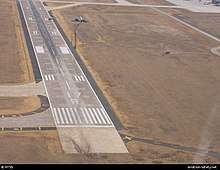Empire Airlines Flight 8284
 N902FX, 2007 | |
| Accident | |
|---|---|
| Date | January 27, 2009 |
| Summary | Unstabilized approach |
| Site | Near Lubbock Preston Smith International Airport |
| Aircraft type | ATR 42–320 |
| Operator | Empire Airlines for FedEx Feeder |
| Registration | N902FX |
| Flight origin | Fort Worth Alliance Airport, Tarrant County, Texas |
| Destination | Lubbock Preston Smith International Airport, Lubbock County, Texas |
| Crew | 2 |
| Injuries | 2 |
| Survivors | 2 (all) |
Empire Airlines Flight 8284 was a cargo flight operated by Empire Airlines for FedEx Feeder between Fort Worth Alliance Airport and Lubbock Preston Smith International Airport, Texas. On 27 January 2009, it crashed on final approach to its destination. Both crew members survived with minor injuries but the aircraft was written off.
Aircraft history
The aircraft operating Flight 8284 was an ATR-42-320, manufactured in 1990 by ATR.[1] Its registration number was N902FX. Before being delivered to Empire Airlines in 2003, and later leased to FedEx in the same year, the aircraft served for three previous airlines: Bar Harbor Airlines, Continental Express and ExpressJet Airlines.[2]
Flight details
The captain in command was a 52-year-old male with a total of 13,935 flight hours, with 12,742 hours as pilot-in-command (PIC). He had 2,052 hours on the ATR 42, 1,896 as PIC. The first officer was a 26-year-old female with 2,109 hours, according to the records of Empire Airlines. She had 130 hours operating the ATR 42 as second-in-command.
Accident
The aircraft approached Lubbock International Airport at around 4:30am in freezing mist.[3]
During the approach there was a flight control problem which prevented deployment of the flaps. The first officer continued the approach while the captain attempted to fix the flaps issue.[4] Neither crew member monitored the airspeed and the aircraft began descending at over 2,000 feet (610 m) per minute, leading to a "Pull Up" warning. The crew pulled up 17 seconds after the initial alarm. The aircraft then entered an aerodynamic stall and crashed.[4][5] The aircraft landed short of the runway threshold, and skidded 3,300 feet (1,000 m) down and off runway 17R. A small fire began shortly after.[6]
The weather conditions did not contribute to the crash.[3]
Investigation


The National Transportation Safety Board (NTSB) investigated the cause of the accident. The flight data recorder and cockpit voice recorder showed that the crew continued the landing after the flaps failed to deploy rather than conducting a go-around. The crew also failed apply maximum engine thrust immediately after the stall, waiting 17 seconds after an TAWS warning had sounded before applying thrust. In postaccident interviews, the captain said that he had sleep fatigue before the flight due to "high-workload situations" which affected his performance. After the investigation was completed the NTSB released their final report in 2011. It concluded with investigators stating that "The National Transportation Safety Board determines that the probable cause of this accident was the flight crew's failure to monitor and maintain a minimum safe airspeed while executing an instrument approach in icing conditions, which resulted in an aerodynamic stall at low altitude. Contributing to the accident were 1) the flight crew's failure to follow published standard operating procedures in response to a flap anomaly, 2) the captain's decision to continue with the unstabilized approach, 3) the flight crew's poor crew resource management, and 4) fatigue due to the time of day in which the accident occurred and a cumulative sleep debt, which likely impaired the captain's performance."
Aftermath
N902FX was badly damaged in the accident and was written off. The crew members were sent to hospital for minor injuries, and were later released. Both returned to flying with FedEx Express a month later.
The NTSB issued nine safety recommendations as a result of the crash, including recommendations to prevent in-flight icing.[4] The crash led to the EASA reviewing airplane stick shakers to protect from stalls[7] and adopting a rule regarding the simulation of icing conditions in flight simulators.[8]
References
- ↑ "Federal Express N902FX (ATR 42/72 - MSN 175) (Ex N15827 ) | Airfleets aviation". www.airfleets.net. Retrieved 2018-02-10.
- ↑ "N902FX Federal Express (FedEx) ATR 42". www.planespotters.net. Retrieved 2018-02-10.
- 1 2 http://www.kcbd.com/global/Story.asp?S=9737826
- 1 2 3 Croft, John (2011-04-27). "NTSB: Pilot error in FedEx ATR 42 crash in Lubbock". flightglobal.com. Retrieved 2018-02-22.
- ↑ Ranter, Harro. "ASN Aircraft accident ATR 42-320 N902FX Lubbock Preston Smith International Airport, TX (LBB)". aviation-safety.net. Retrieved 2018-02-10.
- ↑ "FedEx plane crashes in Texas - CNN.com". www.cnn.com. Retrieved 2018-02-10.
- ↑ https://www.ntsb.gov/investigations/AccidentReports/_layouts/ntsb.recsearch/Recommendation.aspx?Rec=A-12-027
- ↑ https://www.ntsb.gov/investigations/AccidentReports/_layouts/ntsb.recsearch/Recommendation.aspx?Rec=A-11-046